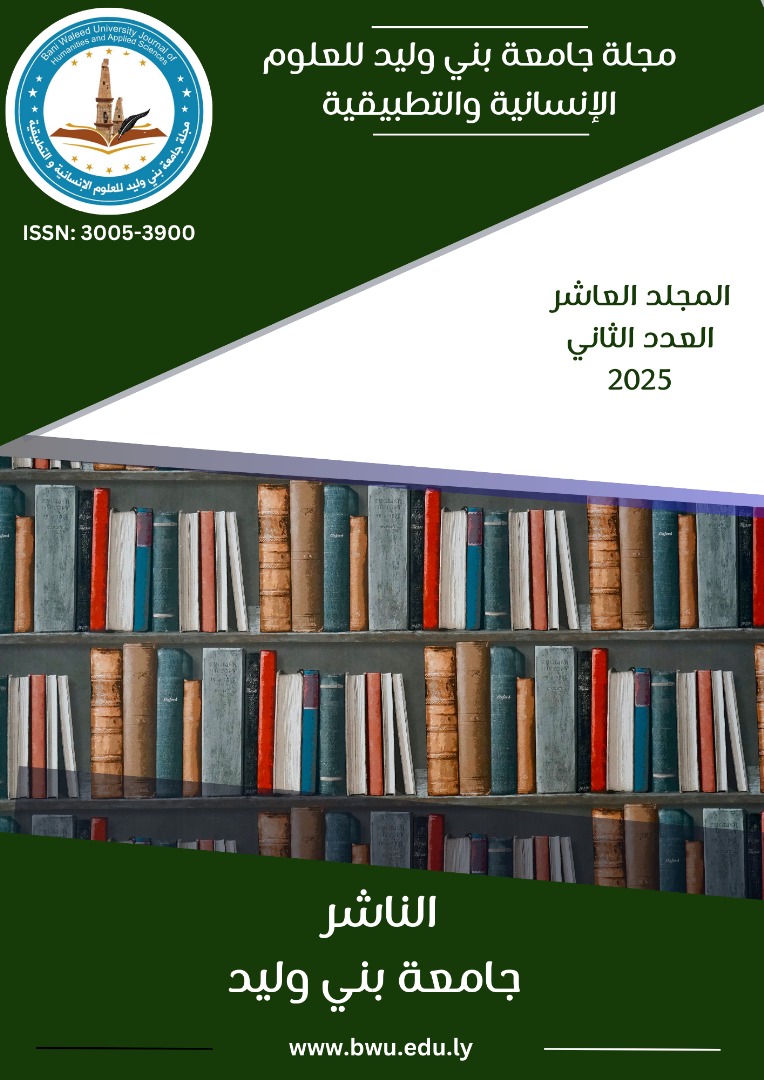التركيب الكيميائي والقيمة الغذائية لأعشاب البحر المختلفة من الساحل الشرقي الليبي
DOI:
https://doi.org/10.58916/jhas.v10i2.745الكلمات المفتاحية:
التركيب الكيميائي، الأحماض الأمينية، الطحالب البنية، الطحالب الحمراء، ADF ، NDFالملخص
تم فى هذه الدراسة تصنيف ستة أنواع من الطحالب البحرية التى تم جمعها من شواطئ مدينتى سوسة والحمامة . وقد كانت الأنواع التى تم التعرف عليها كالتالى : Polysiphonia bradiaei , Laurencia obtusa , Rytiphloeay tinctoria, Cysroseira compressa , C.spinosa , C.corniculata .. إحتوى النوع P. brodiaei علىى أعلى نسبة بروتين خام (16.6% ) يليه النوع tinctoria R. (12.5%) والنوع C.corniculata (12.4%) . وتعد الطحالب المدروسة فقيرة نسبيا فى محتواها من الدهن الخام حيث تراوحت النسب ما بين 0.27 – 1.5% وكان النوعان P.brodiaei و C.corniculata هما الأعلى فى ألياف المحاليل المتعادلة (NDF) والهيميسليلوز بينما النوعان C.spinosa tinctoria ,.R هما الأقل محتوى بالنسبة لل NDF وال ADF .وقد تراوحت نسبة السيليلوز فى الأنواع الأعلى محتوى (R.tinctoria,C.compressa وC.corniculata ) مابين 7.93- 10.7% ومقابل 3.49-6.07% فى الأنواع الأخرى الأقل محتوى. وقد لوحظ ارتفاع كبير فى نسبة الكالسيوم فى جميع العينات حيث تراوحت بين 711.5 الى 4173.6 ملجم/100جم، وتراوحت نسبة الماغنسيوم مابين 219-761ملجم/100جم وتراوح محتوى البوتاسيوم والحديد والنحاس ما بين 6.19- 50.98 و6.08-19.22 و 0.85- 1.84 ملجم/100جم وزن جاف على التوالي. ويتراوح محتوى الطحالب البحرية موضع الدراسة من المنجنيز والزنك ما بين 0.24- 1.27 و 1.14- 10.60 ملجم/100جرام على التوالي. أما بالنسبة لتركيز كل من الرصاص والكادميوم فقد تراوحت بين 0.22-0.33 و 0.01- 0.03 ملجم/100جرام على التوالي.
توجد بعض الاختلافات فى تراكيز الأحماض الأمينية بين أنواع الأعشاب موضع الدراسة حيث لوحظ أن النوع P.brodiaei يحتوى على تركيز مرتفع من السيرين (10.52) ومنخفض فى الأحماض الأمينية الكبريتية (1.49) والفالين(2.38) والليسين(4.92) مقارنة مع الأنواع الأخرى. أما النوع C.spinosa فقد تميز بارتفاع محتواه من التيروسين(13.12) والبرولين(10.56) والسيرين(13.46) على التوالى بينما انخفض فيه تركيز الليسين(2.0) والثريونين(1.57) والفالين(1.57) والألانين(2.77) والاسبارتك(5.4) والجليسين(1.14جم/100جرام بروتين ) على التوالي. وتجدر الإشارة الى أن الأحماض الأمينية الحدية قد اختلفت بين أنواع الطحالب المدروسة، حيث وجد أن حامض الفالين هو الحدى الأول فى الأنواع L.obtusa و R.tinctoria و ,C.compressa بينما مثلت الأحماض الأمينية الكبريتية، الليوسين والليسين الحامض الحدى الأول فى الأنواع P.brodiaei وC.corniculata و C.spinosa على التوالي.
التنزيلات
المراجع
Agregán, R., Munekata, P. E. S., Franco, D., Dominguez, R., Carballo, J. and Lorenzo, J. M.( 2017). Phenolic compounds from three brown seaweed species using LC-DAD-ESI-MS/MS. Food Research International 99(Pt3):979–85.
AOAC. (1997). Official Methods of Analysis, 16 ͭ ͪ ed . Association of Official Analytical Chemists, Washington , DC.
Bamaniyal, P.K., Joshil, N.H., Tiwaril, A. & Shajil, S. 2022. Seaweed - Classification, Source and Uses. Agri-India Today, 2(5): 54.57.
Burtin, P. (2003). Nutritional value of seaweed. Electron. J. Environ. Agric.FoodChem.ISSN1579-4377. Cherry,P.,O´Hara,C.,Magee,P.J., Mc Sorley, E.M. and Allsopp, P.J.(2019). Risks and benefits of consuming edibl seaweeds. Nutrition Reviews , vol. 77 (5) : 307 – 329.
Cian, R.E., Drago, S.R., de Medina, F.S., Martínez-Augustin, O. (2015). Proteins and carbohydrates from red seaweeds: Evidence for Beneficial effects on gut function and microbiota. Mar. Drugs
, 5358–5383
Dawczynski, C., Schubert, R., Jahreis, G.(2007). Amino acids, fatty acids, a dietary fibre in edible seaweeds products. Food Chem.. 891 –899
Duranti, M. and Cerletti, P. (1974) . Amino acid composition of seed protein of Lupinus albus . J. Agric. Food Chem. 27: 977- 978.
El- Said G.F. and El- Sikaily A.(2013). Chemical composition of some seaweed from Mediterranean Sea Coast , Egypet. Egypet. Monit Assess. 185: 6089 – 6099.
Escott-Stump, S. (2008). Nutrition and Diagnosis-Related Care (Lippincott Williams & Wilkins).
FAO/WHO/UNU. (1985). Energy and protein Requirements, Report of the Joint FAO/WHO/UNU Expert Consultation Technical Report Series No. 427. FAO, WHO and the United Nations University Geneva Switzerland.
FAO. 2022. Report of the Expert Meeting on Food Safety for Seaweed Current Status and Future Perspectives. Available at: https://doi.org/ 10.4060/cc0846en. Accessed 19 May 2023
Farghl, A.A. M., Al-Hasawi,Z.M. and El- Sheekh, M.M. (2021). Assessment of antioxidant capacity and phytochemical composition of brown and red seaweeds sampled off Red Sea Coast. Appl.Sci. 11:11079.
Fleurence, J., Ele Morançais,M., Dumay, J., Decottignies, P., Turpin, V. M., Garcia-Bueno, N., and Jaouen, P.( 2012). What are the Munier, Prospects for using seaweed in human nutrition and for marine Animals raised through aquaculture? Trends in Food Science & Technology 27 (1):57–61.
Ghaliaoui, N., Hazzi,t M., Mokrane, H. (2024). Seaweeds as Potential Source of Bioactive Compounds. Research in Biotechnology Environmental Science.3(1):1-8.
Gilbert, E. I. (1998). Juvenile green turtle (Chelonia mydas) foraging ecology : feeding selectivity and forage nutrient analysis M. Sc. Thesis. College of Arts and Science University of Centrol Florida Orlando, Florid, USA.
Goering, H.K. and Van Soest, P.J. (1970). Fiber analysis- apparatus reagents , procedures and some applications (Agriculture Hand book) USDA, Washington, DC, USA.379.
Gomez-Zavaglia, A., Prieto Lage, M. A., Jimenez-Lopez,C.,Mejuto,J.C. and Simal-Gandara, J.( 2019). The potential of seaweeds as a source of functional ingredients of prebiotic and antioxidants value.. Antioxidants 8 (9):406.
Gullón, B., Gagaoua, Barba, M., Gullón, F. J., Zhang, P., W. and Lorenzo J. M. ( 2020). Seaweeds as promising resource of bioactive compounds: Overview of novel extraction strategies and design of tailored meat products. Trends in Food Science & Technology 100:1–18.
Kim,S.,and WijesekaraI.(2010). Development an biological activities of marine-derived bioactive peptides: A review. JFunct.2010; 2:1-9.
Kustantinah, Hidayah, N., Noviandi, C.T., Astuti, A. and Paradhipta, D.H.V.(2022). Nutrients content of four tropical seaweed species from Kelapa Beach, Tuban, Indonesia and their potential as ruminant feed. Biodiversitas. 23 : 6191 – 6197.
LeeJ,C.,Hou,M.F.,Huang,H.W. ,Chang,F.R.,Yeh,.C.C.,Tang, J.Y.,et al.(2013). Marine algal natural products with anti-oxidative,anti-inflammatory, and anti-cancer properties. Cancer Cell Int. 13: 55.
Lomartire, S. & Goncalves, A.M.M. 2022. An Overview of Potential Seaweed-Derived Bioactive Compounds for Pharmaceutical Applications. Mar. Drugs, 20(2): p.141. https://doi.org/ 10.3390/md20020141
Maehre, H.K., Malde, M.K., Eilersten,K. and Elvevoll,E.O. (2014). Characterization of protein, lipid and mineral contents in common of their potential as food and feed . Journal of the science of food and Agriculture. 94 : 3281 – 3290.
Maffei, H. V. L. & Vicentini, A. P.(2011). Prospective evaluation of dietary treatment in childhood constipation: High dietary fiber andwheat bran intake are associated with constipation amelioration. J. Pediatr. Gastroenterol. Nutr. 52(1), 55–59.
Makki, K., Deehan, E. C., Walter, J. and Bäckhed, F.(2018). The impact of dietary fiber on gut microbiota in host health and disease. Cell Host Microbe 23(6), 705–715 .
Misurcova, L., Kracmar, S., Klejdus, B. and Vacek, J. (2010). Nitrogen content, dietary fiber and digestibility in algal food products. Czech J. Food Sci. vol. (28) No. 1: 27 – 35.
Misurcova, L. (2011). Chemical composition of seaweeds. In book. Handbook of Marine Macroalgae : 171 – 192.
Mongeau, R. and Brassard, R. (1979). Determination of neutral detergent fiber, hemicellulose,cellulose and lignin in breads. Cereal Chem. 56 : 437 – 441.
Nizamudden, M. , Menez, E. G. , West, J. A. (1979). A list of marine algae from Libya . Botanic Mareine. Vol. XXII : 465 – 476.
Peñalver, R., Lorenzo, J. M., Ros, G., Amarowicz, R., Pateiro, M. and G. (2020). Seaweeds as a functional ingredient for a healthy Nieto,diet. Marine Drugs 18 (6):301.
Polat, S. , Trif, M. , Rusu, A. , Simat, V. , Ćagalj , M. , Alak, G. , Meral, R. , özogul, Y. , Polat, A. and özogul, F. , (2021). Recent advances in industrial applications of seaweeds. Critical Reviews in Food Science and Nutrition . https://doi.org/10.1080/10408398.2021.2010646.
Premarathna, A.D., Tuvikene,R., Fernando, P.H.P., Adhikari, R., Perera, M.C.N., Ranahewa, T.H., Howlader, M.M.,Wangchuk,P., Jayasooriya, A.P. and Rajapakse, R.P.V.J. (2022). Comparativeanalysis of proximate compositions, mineral and functional chemical groups of 15 different seaweed species. Scientific Reports. 12 : 19610.
Raposo, M.F.D.J., De Morais,A. M. M.B. and De Morais, R. M. S. C. (2016). Emergent sources of prebiotics: Seaweeds and microalga Marine Drugs 14:27.
Rosemary,T., Arulkumar, A., Paramasivam, S., Mondragon- Portocarrero, A. and Miranda,J.M. (2019). Biochemical, micronutrient and physicochemical properties of the dried red seaweeds Gracilaria edulis and Gracilaria corticata. Molecules 24(12):2225.
Salehi, B., Sharifi-Rad, J., Seca, A. M. L., Pimto, D.C.G.A., Michalak, I., Trincone, A., Mishra, A.P., Nigam, M., Zam, W. & Martins, N. 2019. Current Trends on Seaweeds: Looking at Chemical Composition, Phytopharmacology,and Cosmetic Applications. Molecules, 22(24): p.4182. https://doi.org/10.3390/molecules24224182
Sanchez Machado, D., Lopez-Cervantes, J., Lopez-Hernandez, J. & Paseiro-Losada, P. (2004). Fatty acids, total lipid, protein and ash contents of processed edible seaweeds. Food Chem. 85, 439–444 .
Schmid, M., Kraft, L.G. K., Van Der Loos, L. M., Kraft, G. T., Virtue, P. Nichols, P. D. and Hurd, C. L. (2018). Southern Australian seaweeds A promising resource for omega-3 fatty acids. Food Chemistry .265:7–70.
Siddique, M.A.M.(2013). Proximate chemical composition and amino acid profile of two red seaweeds (Hypnea pannosa and Hypnea musciformis) collected from St. Martins Island. Bangladesh. J Fishcicom 7: 178 – 186.
Snedecor,G.W. and Cochran,W.G.(1967).“Statistical methods” , 6th Edition,The lowa State University Press, Ames.
Tiwari,B.K., and Troy,D.J.(2015). Seaweed Sustainability Food and Non-Food Applications. Elsevier, DOI: 10.1016/B978-0-12-418697-2.00001-5.
Usov AI.(2011). Polysaccharides of the red algae. Adv CarbohydrChem Biochem . 65:115 – 217.
Vieira, E. F., Soares,C., Machado, S., Correia, M., Ramalhosa, M. J., Oliva-Teles, M.T., Paula Carvalho, A., Domingues, V. F., Antunes, F., Oliveira,T.A.C., et al. (2018). Seaweeds from the Portuguese coast as a source of proteinaceous material: Total and free amino acid composition profile. Food Chemistry 269:264–75.
Vijay, K., Balasundari, S., Jeyashakila , R., Velayathum, P, Masilan, K., and Reshma, R.(2017).“Proximate and mineral composition of brown seaweed from Gulf of Mannar,” International Journal of Fisheries and Aquatic Studies, vol. 5, no. 5 pp. 106 – 112.
WHO, World Health Organization. (1984). Guidelines for drinking – water quality health criteria and other supporting information. 2: 84-90.
WHO, World Health Organization . (2000). Safety evaluation of certain food addatives and contaminants. International Programme on Chemical Safety.
Xu,T.,Sutour,S.,H.,Casabianca,Tomi, F., Paoli, M.,Garrido,M., Pasqualini,V., Aiello, A., Castola,V. and Bighelli, A.(2015). Rapid screening of chemical compositions of Gracilaria dura and Hypnea musciformis (Rhodophyta) from Corsican Lagoon. International JournaL of Phytocosmetics and Natural Ingredients 2 (1):8.








